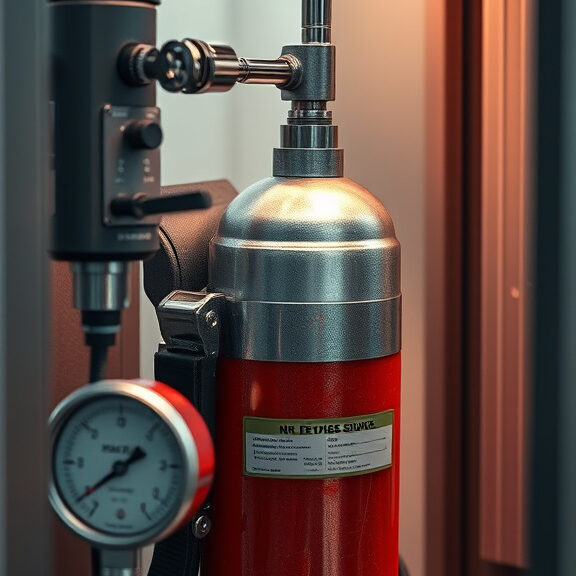Performing a pressure test on a Self-Contained Breathing Apparatus (SCBA) is crucial for ensuring the safety and reliability of this essential equipment used in emergency situations. This comprehensive guide will walk you through the steps to conduct a pressure test, the necessary equipment, and important safety precautions.

Understanding SCBA Components
Before diving into the pressure testing process, it’s important to understand the main components of an SCBA:
- Air Cylinder: The high-pressure tank that stores breathable air, typically rated for 3000 or 4500 psi.
- Regulator: Reduces high pressure from the cylinder to a breathable level (approximately 0.5 to 1.0 psi).
- Facepiece: The mask that provides a seal around the face, allowing the user to breathe the supplied air.
- Hoses and Valves: Connect the cylinder to the regulator and facepiece, facilitating air flow.
Equipment Needed for Pressure Testing
To perform a pressure test on an SCBA, gather the following equipment:
- Pressure Testing Equipment: This includes a pressure gauge, a pressure testing pump, and a suitable testing apparatus.
- Personal Protective Equipment (PPE): Safety goggles, gloves, and hearing protection.
- Calibration Equipment: A calibrated pressure gauge for accurate readings.
- Maintenance Log: To record the results of the pressure test and any maintenance performed.
Preparation for the Pressure Test
Before conducting the pressure test, follow these preparation steps:
- Inspect the SCBA: Conduct a visual inspection for any signs of damage, corrosion, or wear.
- Check the Maintenance History: Ensure the SCBA has been maintained according to the manufacturer’s recommendations.
- Ensure Proper Environment: Perform the test in a safe, well-ventilated area away from flammable materials.
Performing the Pressure Test
Step 1: Set Up the Testing Apparatus
- Secure the SCBA Cylinder: Place the SCBA cylinder in the testing apparatus, ensuring it is securely fastened.
- Connect the Pressure Gauge: Attach the calibrated pressure gauge to the cylinder valve, ensuring all connections are tight.
Step 2: Conduct the Pressure Test
- Open the Cylinder Valve: Slowly open the valve on the SCBA cylinder to allow air to flow into the testing apparatus.
- Increase Pressure: Use the pressure testing pump to gradually increase the pressure to the specified test pressure (usually 1.5 times the rated pressure).
- Stabilize the Pressure: Maintain the pressure for a specified duration (typically 5 to 10 minutes) to allow any potential leaks to become apparent.
Step 3: Monitor for Leaks
- Check for Pressure Drop: Monitor the pressure gauge for any drop in pressure during the stabilization period.
- Use Soapy Water: If a leak is suspected, apply a soapy water solution to the connections and fittings. Bubbles will indicate leaks.
Step 4: Document the Results
- Record the Pressure Readings: After the stabilization period, document the final pressure reading in the maintenance log.
- Note Any Issues: Document any leaks or issues encountered during the test, along with corrective actions taken.
Post-Test Procedures
After completing the pressure test, follow these steps:
- Release the Pressure: Carefully release the pressure from the SCBA cylinder by slowly closing the cylinder valve.
- Inspect the SCBA Again: Conduct a final inspection to ensure no damage occurred during testing.
- Perform Necessary Repairs: If leaks or issues were identified, perform repairs or replace components as needed.
- Re-test if Necessary: If repairs were made, repeat the pressure test to ensure the SCBA is functioning correctly.
Safety Precautions
When performing a pressure test on an SCBA, adhere to the following safety precautions:
- Use Proper PPE: Always wear appropriate personal protective equipment.
- Follow Manufacturer Guidelines: Adhere to the manufacturer’s instructions for pressure testing and maintenance.
- Work in a Safe Environment: Ensure the testing area is free from hazards.
- Have Emergency Procedures in Place: Be prepared for emergencies, including having a fire extinguisher and first aid kit readily available.
Conclusion
Performing a pressure test on a Self-Contained Breathing Apparatus (SCBA) is vital for ensuring the safety and reliability of this critical equipment. By following the outlined steps and adhering to safety precautions, personnel can effectively test the integrity of the SCBA, ensuring it is ready for use in emergencies. Regular pressure testing, along with proper maintenance and inspections, is essential for the longevity and effectiveness of SCBA equipment in protecting lives during emergencies.
